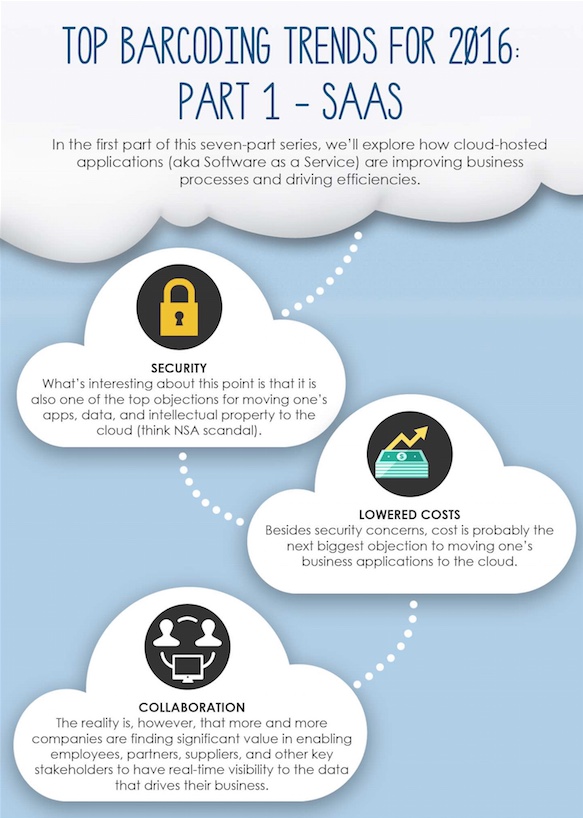Top Barcoding Trends for 2016: Part 1 – SaaS
In the first part of this seven-part series, we’ll explore how cloud-hosted applications (aka Software as a Service) are improving business processes and driving efficiencies. By Eric Sutter. 
As a 15-year veteran of the barcoding industry, I’ve seen a lot of changes over the years. In the past couple of years, however, the pace of change has picked up significantly with warehouse management systems. One area the where this can be seen most prominently is the cloud. Three years ago, the thought of running a warehouse, distribution center, logistics company, or retail business “in the cloud” would have been laughable to many small to midsize business owners, but today that’s all changed. There are now a lot of good reasons to consider moving some aspects of your business to the cloud. Here are three big reasons to consider:
Security – What’s interesting about this point is that it is also one of the top objections for moving one’s apps, data, and intellectual property to the cloud (think NSA scandal). In fact, two-thirds of IT pros recently surveyed by software vendor Netwrix said security and privacy of sensitive data is their chief concern when it comes to the cloud. A lot of the problems related with security come down to the vast difference between consumer-grade cloud services and those geared toward businesses. Here are four specific security benefits business-grade cloud services offer over traditional, premise-based alternatives:
1. Business-grade cloud providers use SSAE (statement on standards for attestation engagements) 16 certified data centers, which not only utilize the highest levels of network security, but strict physical security and business continuity features are included as well.
2. With business-grade SaaS offerings, data is encrypted before it leaves the user’s facility and during transit (often using 256-bit AES encryption, which is the same as that used by many banking institutions for online banking).
3. SaaS providers further protect their customers’ data via granular access rights based on user roles. This is often the Achilles heel of consumer-grade services, which even if they do have adequate physical and network security features built-in, leave end users vulnerable by permitting easily guessed (and easily hacked) user name and password combos.
4. Centralized administrative control is another security benefit with business grade SaaS offerings. If, for example, an employee terminates employment with the company, the designated administrator of the account can quickly and easily remove the former employee’s access to the application via a secure Web portal.
Lowered Costs – Besides security concerns, cost is probably the next biggest objection to moving one’s business applications to the cloud. The reason for this concern is that companies look only at initial costs instead of the bigger picture, which is the total cost of ownership. For example, let’s say that it costs $1,000 to purchase a traditional (i.e. on premise) WMS compared with $100 a month for a SaaS subscription. The traditional WMS will become more cost-effective than the SaaS subscription after 10 months, right? That’s not the case, and here’s why: The license is only one aspect of the total cost of owning the software. If you’re using the software internally, you have to consider the server your running the software on. That server needs to be monitored, updated regularly, and it takes power not only to run the server, but also to ensure it’s kept at a certain temperature. With a SaaS subscription, on the other hand, this burden is handled by the cloud provider and all those costs are rolled into the monthly subscription. Plus, you never have to worry about downtime or updates, which leaves more time to focus on what you do best, which is running your business.
Collaboration – For companies that operate in a closed-loop environment, where data is shared only among workers within the same four walls, this last point won’t be of much value. The reality is, however, that more and more companies are finding significant value in enabling employees, partners, suppliers, and other key stakeholders to have real-time visibility to the data that drives their business. For example, when a truck driver scans a pallet and loads it onto the trailer, it’s helpful for the company that will be receiving the pallet to get an automated alert. Or, if a manufacturer is running low on supplies, there are obvious benefits if a supplier can be alerted to this fact and can take care of replenishing supplies before they run out. All these types of communication and collaboration happen more easily and effectively via the cloud and utilizing SaaS, which is designed with these needs in mind.
There is not doubt that cloud computing and the SaaS subscription model are going to continue growing in popularity and will eventually become the standard for all companies. The big question is, will your company give this new business model the credence it deserves, or will you allow fears and misperceptions to govern your thinking and try to maintain the status quo?
 Eric Sutter is a business development professional with more than 15 years of experience providing asset tracking, inventory tracking, and time and attendance solutions across a wide range of vertical markets. Sutter founded EMS Barcode Solutions in 2010 on the premise that customers need more than data collection devices and software — they need solutions. By combining and integrating components such as mobile computers, software, labels, and ribbons with professional services EMS delivers solutions that provide its customers with a tangible return on their investments. Click here to request a consultation.
Eric Sutter is a business development professional with more than 15 years of experience providing asset tracking, inventory tracking, and time and attendance solutions across a wide range of vertical markets. Sutter founded EMS Barcode Solutions in 2010 on the premise that customers need more than data collection devices and software — they need solutions. By combining and integrating components such as mobile computers, software, labels, and ribbons with professional services EMS delivers solutions that provide its customers with a tangible return on their investments. Click here to request a consultation.
